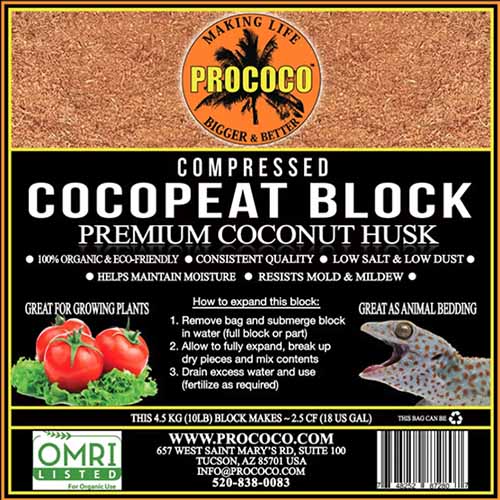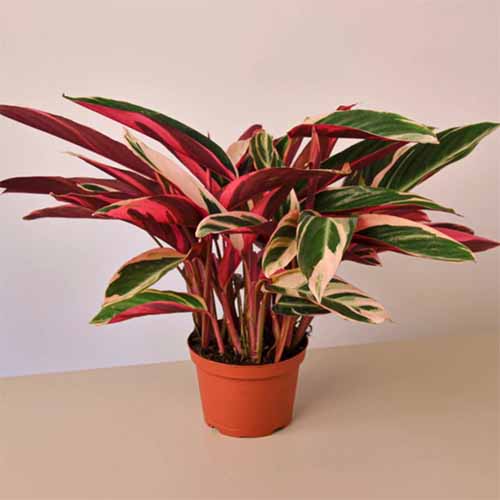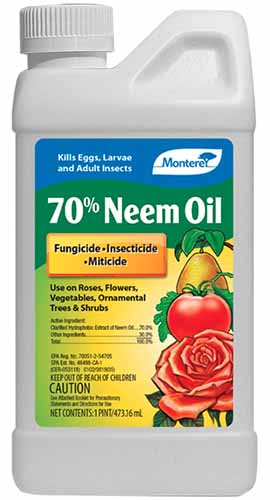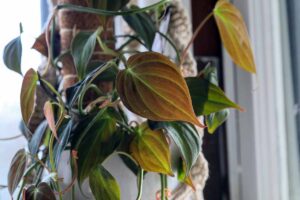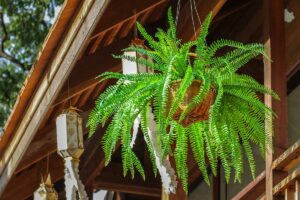Stromanthe thalia ‘Triostar’
Are you looking for a plant that will remind you of its presence every single day? If so, you might not find a better candidate than the vivacious ‘Triostar.’
This houseplant has vibrantly colored leaves that will prevent you from ever setting it and forgetting it. And you won’t want to!
This gem prefers regular attention, and will reward your efforts with painterly patterns, bright and luscious pinks, and leaves that rise and fall with the rhythms of day and night.

We link to vendors to help you find relevant products. If you buy from one of our links, we may earn a commission.
I’m going to cover everything you’ll need to know to take care of this star of a prayer plant. Ready to begin?
What You’ll Learn
If you want to know even more about this fascinating family of flora, or are looking for general growing guidance for marantas, stromanthes, goeppertias (also known as calatheas), and ctenanthes, be sure to consult our complete guide to caring for prayer plants.
What Is Stromanthe Triostar?
‘Triostar’ is a cultivated variety of the species Stromanthe thalia, a plant native to tropical rainforests of Brazil.
The naturally occurring species is gorgeous in its own right, with shiny, dark green foliage that has deep maroon undersides.
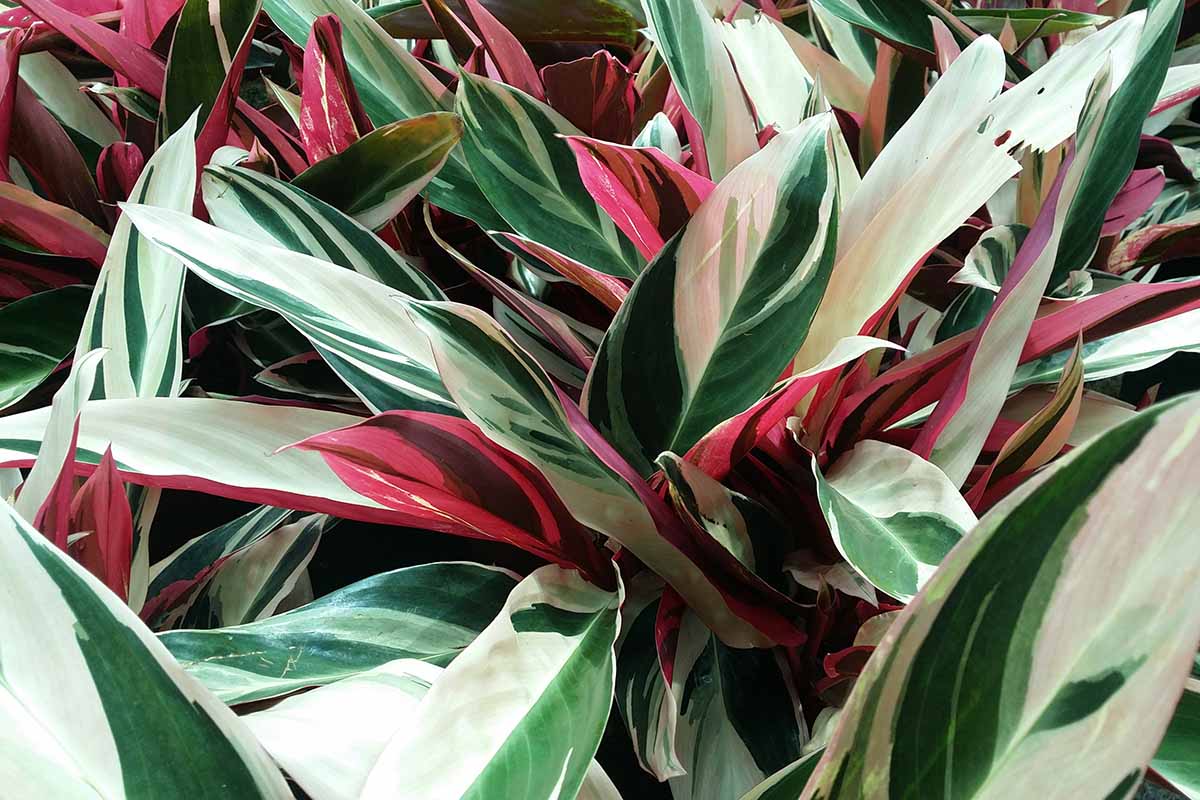
‘Triostar’ takes this striking foliage and adds irregular splashes of white, cream, and pale pink, and light green variegation. Contrasted against lighter-colored leaves, the hot pink undersides of its foliage really stand out.
With a fountain-like growth habit, ‘Triostar’ grows to be three to five feet tall and two to three feet wide, but is more likely to remain under three feet tall as a houseplant.
The oblong, lanceolate foliage features delicate patterns that look like watercolors applied by a painter’s brush when viewed up close.
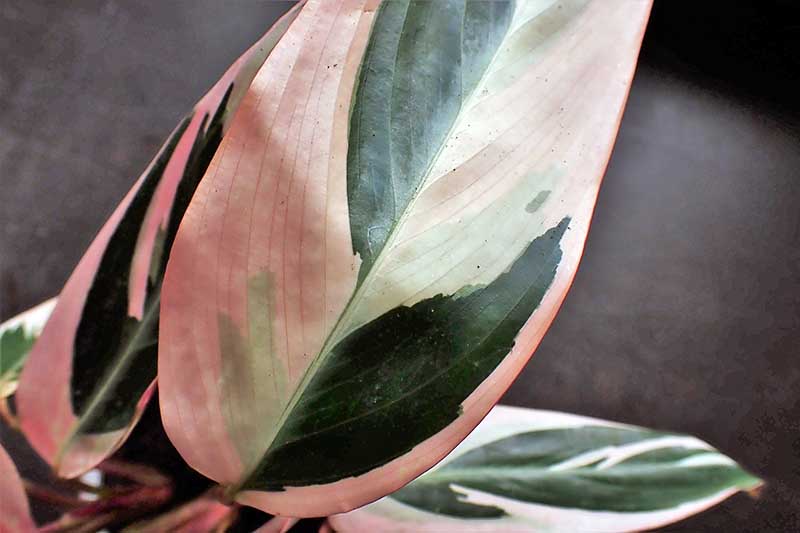
In addition to its striking coloring and mesmerizing patterns, the leaves of ‘Triostar’ are thick and glossy, and can grow up to twenty inches long and six inches wide.
Evoking its cultivar name, the spread of this tricolor stromanthe’s leaves can give the impression of a star-like shape.
Though rarely seen on specimens kept indoors, ‘Triostar’ may produce inflorescences that are pinkish red with white flowers that form in loose clusters, and bloom in spring or summer.
In the wild, or when cultivated outdoors, these prayer plants are pollinated by bees and hummingbirds.
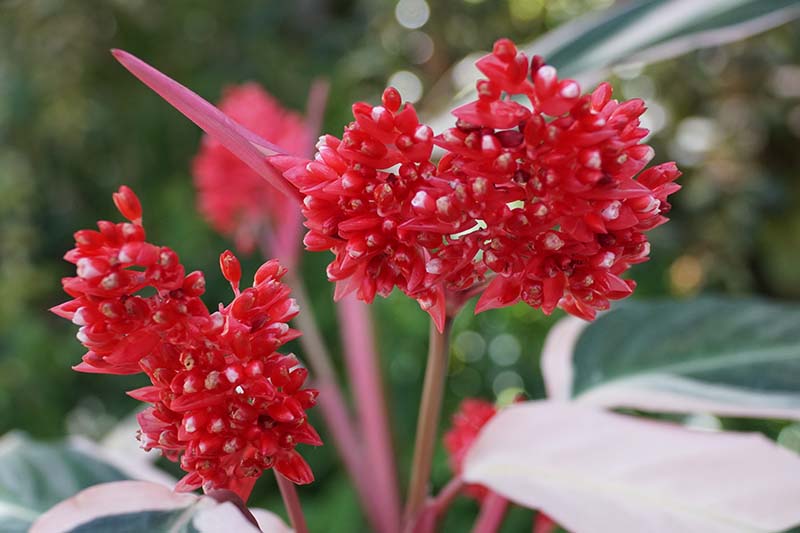
S. thalia spreads via underground rhizomes, allowing these plants to form a ground cover – and making it easy to propagate them via division.
This species is a member of the arrowroot family or Marantaceae, also known as the prayer plant family. Included among its members are the goeppertias (also known as calatheas), ctenanthes, and marantas.
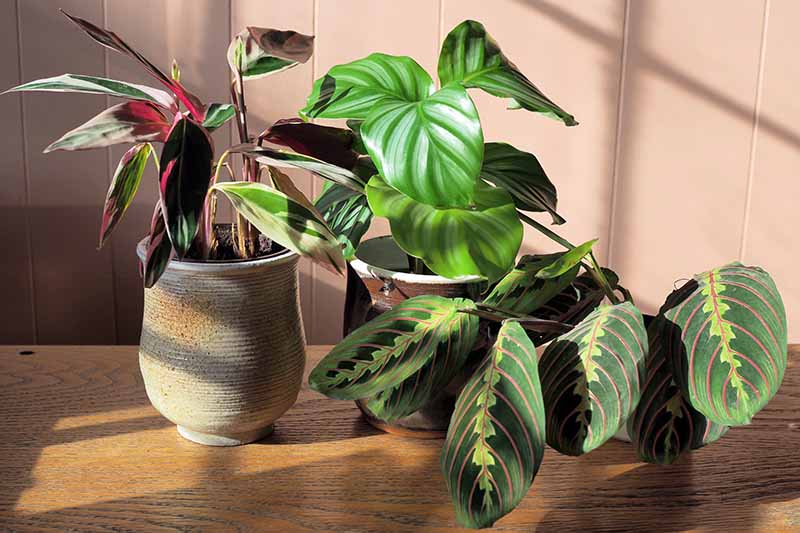
It would be understandable if you were to confuse this cultivar with one of its Goeppertia relatives, ‘Fusion White.’
This other cultivar is a member of a different genus, but the two plants do have a very similar look to them – they both have irregular and rather impressionistic leaf patterns.
However, ‘White Fusion’ has lavender leaf undersides, rather than pink ones, and wavy leaves.

More frequently, though, gardeners confuse S. thalia ‘Triostar’ with a cultivar of Ctenanthe oppenheimiana called ‘Tricolor.’ While the two prayer plants do bear a resemblance, I believe the confusion results more from widespread misidentification of the ctenanthe.
Both have oblong leaves that have dark green coloration along with shades of lighter green, and are variegated with cream and pink. Both cultivars also have brightly colored leaf undersides that might be described in shades ranging from maroon to hot pink.
So how do you tell the difference between the two? There are a couple of very telling differences.

To start with, the ctenanthe’s leaves have a symmetrical fishbone pattern with sections of creamy variegation that look, to me, as if someone came along and erased sections of the main pattern haphazardly.
The subject of our article, on the other hand, does not have any fishbone stripes on its leaves – and its pattern is entirely lacking in symmetry.
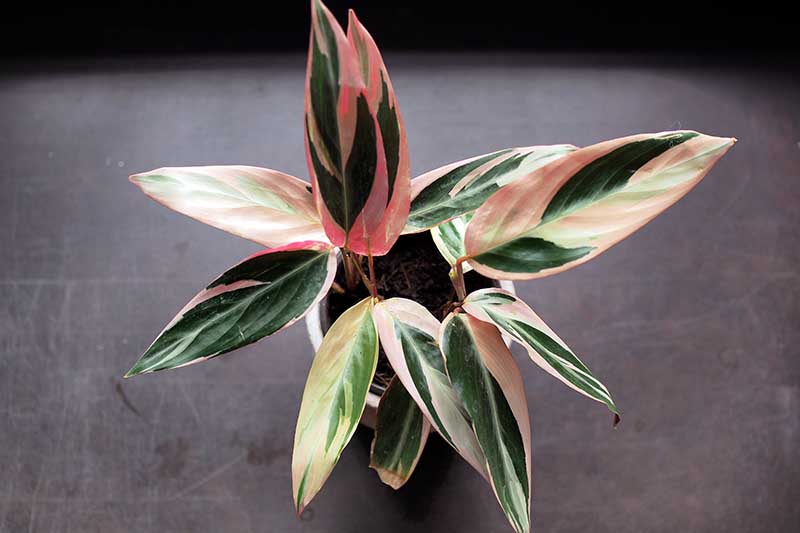
Another big giveaway when trying to differentiate the two will likely only be discernible when these plants are grown outdoors or in a greenhouse – that’s their flowers. The ctenanthe bears yellow and white flowers, not reddish pink and white ones like the subject of our article.
So be aware that many, many, many sources you’ll come across get these two plants mixed up! Now you’ll know better.
Also, when looking for either of these species to purchase, in North America you are more likely to find a stromanthe ‘Triostar’ for sale than a ctenanthe ‘Tricolor’ – and if you find the latter, it may just be a ‘Triostar’ that’s going through an identity crisis.
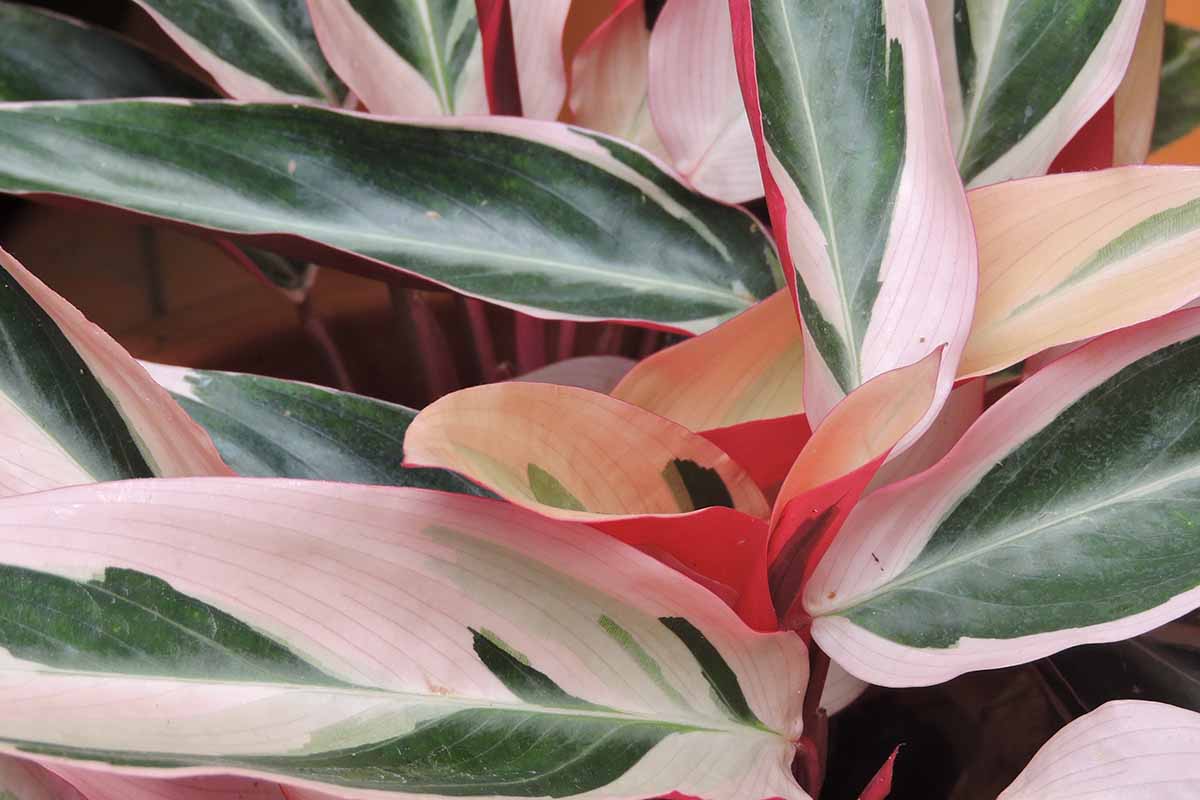
To make matters just slightly more confusing, the subject of our article is also sometimes called stromanthe ‘Tricolor,’ as well as stromanthe ‘Tristar.’
This cultivar is also frequently referred to as calathea ‘Triostar,’ and although it is a member of the prayer plant family, it is not a true calathea since it’s not a member of the Goeppertia genus (formerly known as the Calathea genus).
And speaking of genera, the words that make the genus name, Stromanthe, come from Greek and mean “bed” (stroma) and “flower” (anthos), referring to the shape of the inflorescences of plants in this genus.
We’re not done playing the name game yet! The species S. thalia was formerly classified as S. sanguinea, and you will often still see this name online and in plant nurseries.
Sanguinea means “blood red,” giving the species another of its common names, “bloody stromanthe.” And so it follows that the subject of this article is also sometimes called “variegated bloody stromanthe.”
Since ‘Triostar’ is a prayer plant, you will notice it lifting its leaves up at night after the sun goes down, and lowering them again in the morning after sunrise. Each stem does this with the help of a wrist-like structure called a “pulvinus.”

These stromanthes also turn their leaves towards the sun – if you turn your plant around from its sun-facing orientation, the next day you will find its leaves facing the sun again.
While this cultivar makes an excellent houseplant, it can also be used outdoors in certain locations.
In USDA Hardiness Zones 9b to 11, they can be used as evergreen perennial ground covers, while in areas with colder winters, some gardeners grow them outdoors as summer annuals.
However, keep in mind that since this species originates in a humid, tropical habitat, this variety would be more suited to outside use in Florida than in Arizona.
Propagation
Seeds are hard to come by for stromanthes, and cultivars tend to produce sterile seeds.
So the best way to propagate variegated bloody stromanthe is via division – separating clumps of rhizomes from a single specimen into two or more separate pots.
The best time to take on this project is in the springtime, just as new growth begins.
Before you get started, inspect the stromanthe to see how you’re going to divide it. Each rhizome will send up its own group of stems.
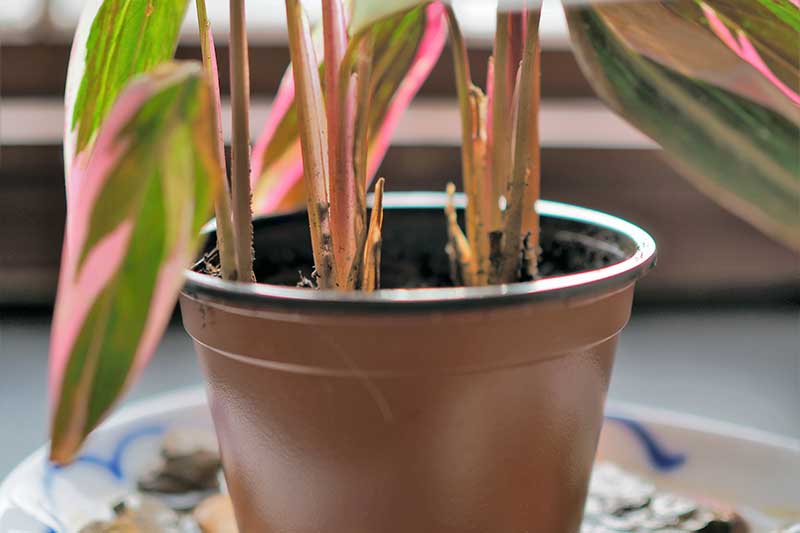
Make sure a clump has at least three leaves coming up from it for best results.
Gently separate the clumps from each other, then pot them each into a separate container. You’ll find detailed repotting instructions below, so keep reading!
How to Grow Stromanthe Triostar
Stromanthe ‘Triostar’ will grace your home with gorgeous eye-catching foliage if you provide it with the care it prefers. Here’s what you need to know:
Choosing a Specimen
Make sure you get off to a good start by choosing a healthy specimen. Look for one that has no yellowing or brown leaves, and inspect the stromanthe for signs of pests and disease – you’ll find more tips on what to look for later in this article.
Also, check to see that the houseplant is growing in a pot with drainage holes, and is planted in peaty soil to help with water retention.
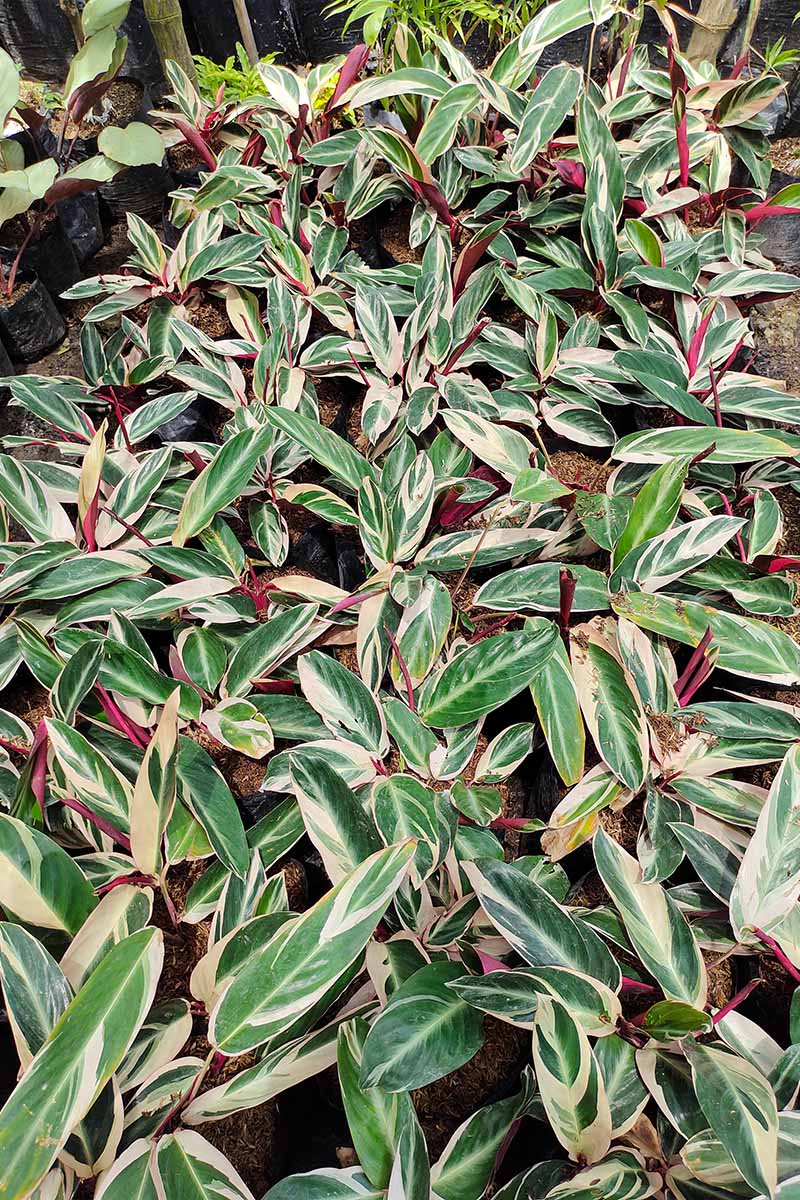
If you’re purchasing a specimen online, since you won’t be able to inspect it in person before making a decision, read reviews from other customers to get a sense of the vendor’s reputation, and check to see whether they provide any guarantees on the plants that they sell.
Don’t forget about the elements! Be sure to request a heat pack for shipment during the winter if you live in a climate that experiences cold winters.
And as soon as your stromanthe arrives, check it over for signs of pests or disease, and contact the seller immediately if anything looks to be amiss.
Light
Once you have welcomed your new stromanthe home, you’ll want to find it a suitable location with the right amount of light.
Ideally, provide your plant with medium indirect light. A little direct sun in the early morning is okay, but avoid hot sun from noon to evening.
Depending on the conditions around your home, placing your houseplant a few feet from an eastern-facing window might provide the plant with the amount of light it needs.
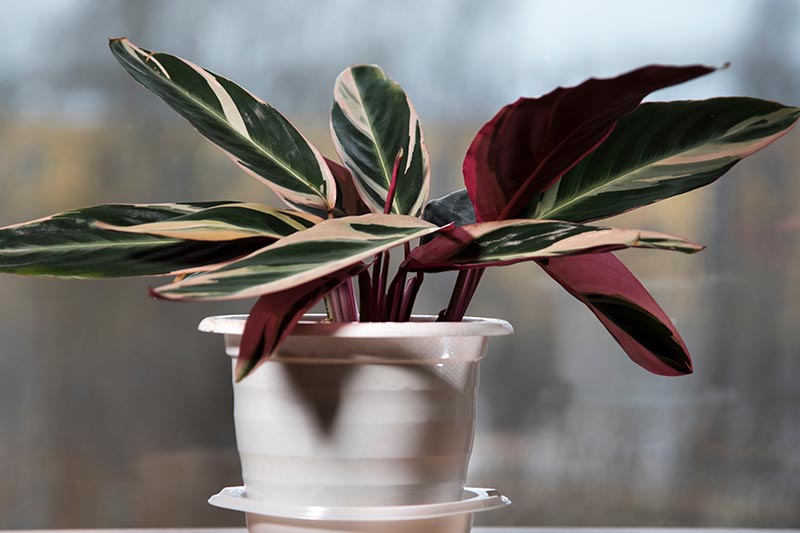
If your main source of light is a south- or west-facing window, make sure to scoot the ‘Triostar’ back several feet. My variegated bloody stromanthe lives about ten feet from my south-facing kitchen window.
Avoid placing this houseplant directly on a windowsill. This can be helpful not only in preventing it from getting too much direct light, but also in keeping it protected from the temperature fluctuations that can take place next to a windowpane. We’ll talk more about this in the section on temperature below.
Also, know that this stromanthe will tolerate lower light, but it will lose some of its variegation when grown in such conditions, with the foliage taking on a greener hue.
Temperature
According to Susan Mahr, former coordinator of the Master Gardener program at the University of Wisconsin-Madison Department of Horticulture, ‘Triostar’ can survive temperatures down to freezing (32°F), though its foliage will be killed back.
Rather than pushing it to its limits, try to keep it in the temperature range it prefers – a comfortable 65 to 80°F.
Once you have your houseplant in a location with a comfy temperature, check around the room and make sure it doesn’t have any cold drafts or sources of hot, blowing air.
Areas to watch out for are doors leading outside, drafty windows, fireplaces, and forced air vents.
Variegated bloody stromanthe, like other members of the Marantaceae family, is sensitive to temperature fluctuations and will let you know of its displeasure in such conditions by reacting with browning leaves.
Water
After positioning your variegated bloody stromanthe in a location where it gets just the right amount of light and is enjoying life in a comfortable temperature range, the next aspect of its care that you’ll want to master is to keep it watered well.
S. thalia ‘Triostar’ likes to have moist but not soggy soil, so you don’t want to let it dry out much at all.
Although many sources recommend watering stromanthe ‘Triostar’ as soon as its soil is dry to the touch, when planted in a peaty growing medium, it can be hard to gauge this.
The peaty growing mediums typically used for prayer plants don’t always change color when they are dry, and sometimes they don’t even feel dry to the touch until they are much too dry.
It can be helpful to judge your stromanthe’s watering needs based on how heavy its pot feels instead.
After watering, lift your houseplant’s pot and make a mental note of how heavy it feels. If you aren’t sure when to water again, start off with a weekly check-in. Lift the stromanthe again. It should feel lighter, but not so light that the plant seems to want to fly away.
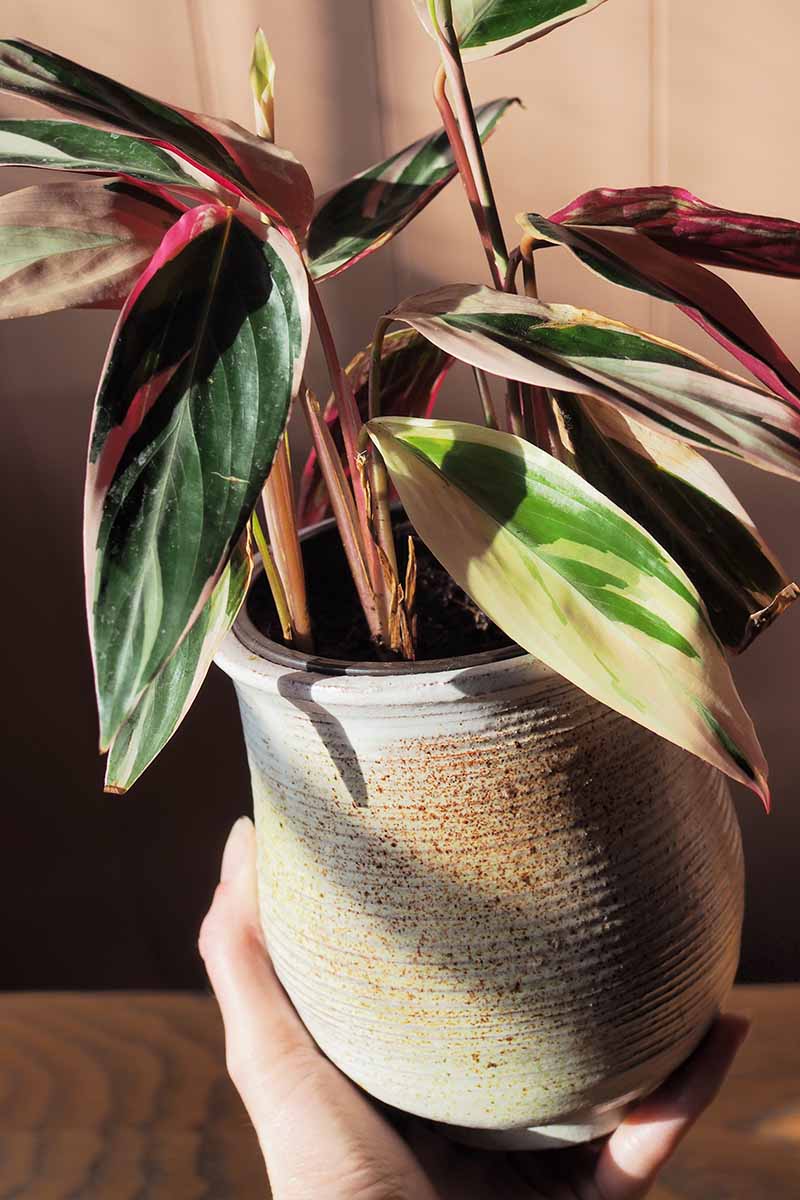
If your variegated bloody stromanthe has started to wilt or has stopped the daily lowering and raising of its leaves, you have waited too long between waterings.
Does your ‘Triostar’ seem to require watering more often than once a week? If so, either water it more frequently, relocate it to a slightly cooler location, or consider repotting it into a slightly larger pot.
During winter, you can decrease the frequency of your watering visits, perhaps shifting your watering schedule to every ten days or so.
But when it is watering time, don’t use just any old tap water! Like the other prayer plants, ‘Triostar’ is sensitive to contaminants that are frequently found in tap water, so provide rainwater, distilled water, or filtered water instead.
If using filtered water, some gardeners recommend choosing a filter that removes fluoride as well as various impurities.
When you’re ready to water, remove your stromanthe from its decorative cachepot if it has one, and place it in a bowl, sink, or bathtub.

Next, pour water over the surface of the stromanthe’s growing medium (not over its foliage) until liquid runs out of the drainage holes in the bottom of the nursery pot.
I like to pour water through a second and sometimes a third time to make sure my ‘Triostar’ gets a good soaking.
Once your ‘Triostar’ has been thoroughly soaked, drain the water from the bowl or sink, and let the plant continue to drain its excess water. Once the plant is no longer draining liquid, return it to its usual location.
If you happen to neglect your houseplant one week and it becomes overly dry before being watered, give it an extra-long soaking when you do water it. Sometimes it takes longer to rehydrate when the potting medium gets a bit too dry.
You may also want to try a method called bottom watering – you can learn more about the bottom watering method in our article.
Although you’ll want to err on the side of overwatering versus underwatering with these stromanthes, it is possible to damage them with too much water.
You’ll learn more about root rot in the section on disease, still to come in this article.
Humidity
Triostars are known as being a tad fussy, and one of the biggest reasons for this is that they prefer life on the humid side.
How humid? It’s best to keep them at a relative humidity above 50 percent.
Even if you live in a humid climate, if you heat your home during the cooler months, it’s likely that your indoor air dries out significantly in winter.
To make sure you provide your ‘Triostar’ with the air moisture it needs, first know what you’re starting with. You can do this by using a hygrometer, a simple tool for measuring relative humidity.
If you’d like to invest in a combo hygrometer and thermometer to make sure you’re keeping your houseplants in their ideal conditions, you can find one available for purchase from LittleGood via Amazon.

Thermometer and Humidity Gauge
If you determine that you need to increase the humidity of your indoor air, you have a few different options.
First, consider grouping your stromanthe together with some houseplant companions. This will create a microclimate where the air moisture will be higher.
Next, consider placing your ‘Triostar’ on a humidity tray containing pebbles and water. The water will evaporate around the plant, adding moisture to the air, while the pebbles keep the plant raised above the water level.
You can easily make your own humidity tray with a ceramic, glass, or plastic tray or plate filled with pebbles and water.
Just make sure the pot is positioned above the water and not sitting in it, so the plant doesn’t wick up water through its drainage holes. You’re trying to create a humid zone, not a bog! A drainage saucer placed beneath the pot can help to prevent this as well.
Would you rather purchase a pebble tray instead of going the DIY route? You’ll find one available from 9GreenBox via Amazon.

If you live in a particularly arid climate like I do, you might want to use all of these options – and go one step further. I keep my ‘Triostar,’ a couple of other prayer plants, and a pebble tray housed inside a mini greenhouse.
I personally use terrariums and mini greenhouses to house all of my more sensitive and humidity-loving houseplants. You can find one of my favorites, the Socker mini greenhouse from Ikea, available via Amazon.
If you have a larger specimen that won’t fit in a terrarium or mini greenhouse, place a humidifier nearby, and consider using some of the other options mentioned here as well.
If you fail to get your watering and humidifying routine just right with a prayer plant, this can result in crispy leaf edges. But there are other factors that can cause brown leaves, too – learn about seven of the top reasons for brown leaves on prayer plants in our article.
Growing Tips
- Provide medium, indirect light.
- Keep soil moist but not wet, and provide extra humidity as needed.
- Avoid drafts and temperature extremes.
Pruning and Maintenance
Variegated bloody stromanthe may appreciate frequent visits from the human carrying the watering can, but this plant is pretty low-maintenance otherwise. Here are some additional tips:
Pruning
Even the most attentive plant parent sometimes finds a slightly crispy leaf edge on a ‘Triostar.’
In this case, you may want to trim any browning leaves, edges, or tips from your specimen.
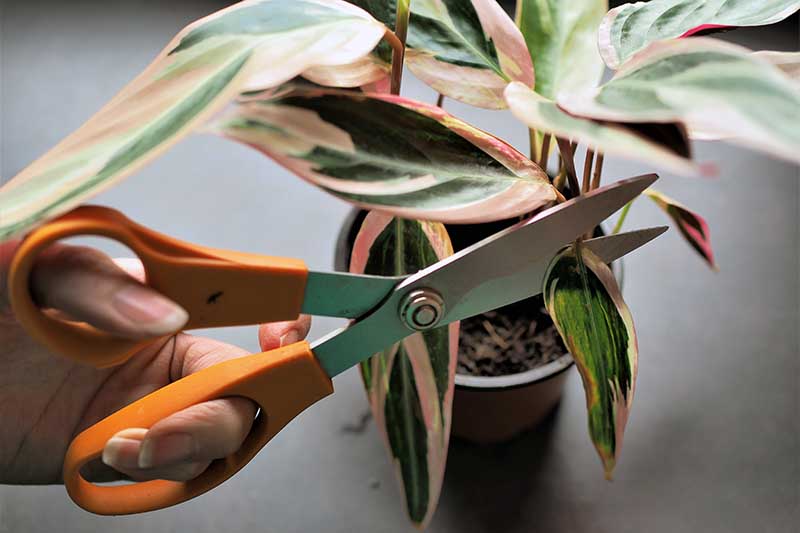
When trimming brown tips or edges, you can simply use a pair of clean, sterilized scissors to cut off the brown parts from the leaf. To sterilize your scissors, wipe them down with hydrogen peroxide.
If you find an entire leaf that has turned brown, clip the stem close to the surface of the soil.
Apart from this aesthetic upkeep, there’s no need to prune your houseplant.
Repotting
These aren’t particularly fast-growing plants, so your variegated bloody stromanthe will only need to be repotted every two or three years.
You’ll know it’s time when your specimen starts to dry out too quickly, or you find roots emerging from the drainage holes of its pot.
It’s important to wait until ‘Triostar’ actually needs repotting, because overly frequent sizing up of the container can sometimes lead to root rot. When planted in an oversized pot, the growing medium can take too long to dry out, creating overly soggy conditions.
When it is time, try to plan your repotting project for early spring, when the plant is starting to grow more actively.
First, you’ll want to gather up your potting supplies – start with a pot. Choose a new pot that is just one size up from the current size, and make sure it has drainage holes.
If you’d like to use a decorative cachepot that has no drainage holes, you can use this as an outer accoutrement, but repot your ‘Triostar’ into a nursery pot with holes.
After selecting your pot, you’ll also need to choose a growing medium. This stromanthe prefers slightly acidic soil that is rich and peaty.
I like to make my own blend for these houseplants – I use one part coconut coir and one part De La Tank’s Houseplant Mix. This blend provides a good balance between water retention and drainage.
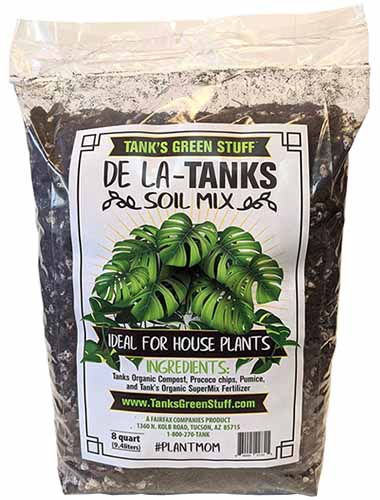
Soil Mender’s 109 Potting Mix is available for purchase at Arbico Organics in a variety of package sizes.
And if you need a source for coconut coir, you can find a ten-pound compressed block from Prococo, also available at Arbico Organics.
Once you are ready to repot, place a small amount of the soil in the bottom of your new pot.
Then slide your ‘Triostar’ out of its old pot, and gently loosen up its roots by rubbing your hand along the sides of the root ball.
Place the stromanthe in its new pot and adjust if needed, adding more or taking away some of the soil beneath the root ball, so there’s about a half an inch to an inch of space between the top of the soil and the rim of the pot.
Once it’s well situated within its new pot, backfill with potting medium, tap the pot gently on your work surface to settle the soil in, give your ‘Triostar’ a drink, and return it to its usual location.
Fertilizing
As a sensitive houseplant, Triostar will reward you if you follow a gentle fertilizer regimen.
I like offering this prayer plant worm compost tea. If you don’t have a vermicomposting station of your own set up yet, you can purchase tea sachets to do the job while you’re watering.
You just soak the bags in your watering water for several hours, then water your houseplant with the vermicompost-infused liquid.
You can find organic worm compost tea sachets available for purchase from Earthworm Technologies via Amazon.

Teadrops All Purpose Houseplant Fertilizer
You’ll only need to fertilize twice a month, and only during the growing season.
Cleaning the Leaves
There’s one small maintenance task that you should take care of every time you’re watering – cleaning the lovely, multicolored leaves.
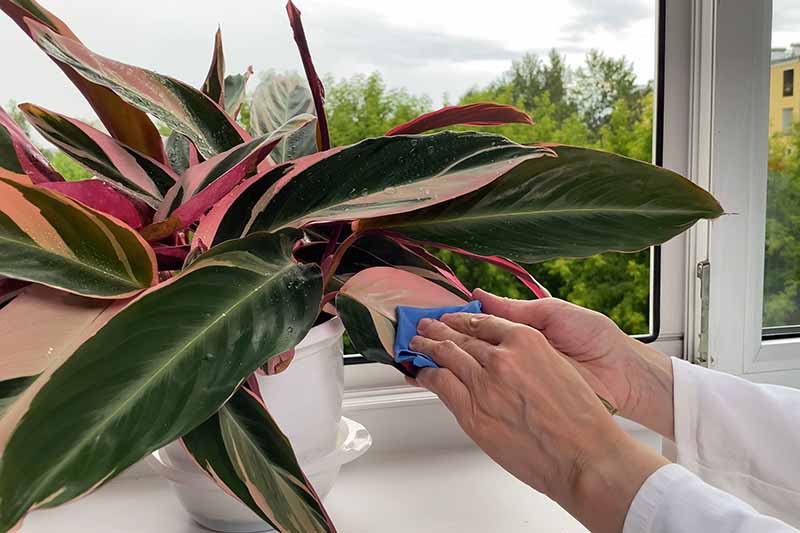
There’s no need to use any special products to do this; simple water will do. Get a damp cloth or paper towel and gently wipe the tops and bottoms of your stromanthe’s leaves to remove any dust that has accumulated on them.
Singing to your stromanthe while you do this task is highly recommended, but optional. It might not do anything for your plant, but it will probably make you feel good, so why not!
Where to Buy
If you’re ready to add a stromanthe ‘Triostar’ to your collection of houseplants, you’ll want to decide where to buy a specimen, and I’ll provide a few recommendations here.
I’ll also provide a few different size options. While variegated bloody stromanthe can eventually reach about three feet tall and two feet wide, it’s a fairly slow-growing houseplant.
When you’re ready to purchase a specimen of your own, you may want to start with whatever size that will work best to meet your present needs in the available space.
Small
Want to enclose your bright star of a houseplant in a cozy terrarium? Start with a four-inch pot or something smaller.

Live S. Thalia ‘Triostar’ Plant in 4”-Pot
You’ll find a petite stromanthe ‘Triostar’ in a four-inch pot available from Hirt’s Gardens Store via Amazon.
Medium
For a desk-sized specimen, a six-inch plant will offer a full pot of foliage to brighten up your workspace.
Live S. Thalia ‘Triostar’ Plant in 6”-Pot
You can purchase a live plant in a six-inch pot from the House Plant Shop via Walmart.
Large
If you’d like to start with a larger specimen, say for a floor location, start with a plant in an eight-inch pot or something larger.

Live S. Thalia ‘Triostar’ Plant in 8”-Pot
You’ll find a live plant available for purchase in an eight-inch pot from Wekiva Foliage via Amazon.
Managing Pests and Disease
‘Triostar,’ like most of its arrowroot family relatives, tends to be fairly pest and disease free. However, it’s helpful to know which pests and diseases are the most likely to show up, on the off chance that you do have a problem.
Insects
Your ‘Triostar’ may pick up a bug or two from spending time outdoors in the warmer months, or a newly acquired specimen may come with a few hitchhikers lurking within its foliage. Here’s what to look for:
Mealybugs
Let’s start with mealybugs. These bothersome but nevertheless fascinating insects look like bits of fluff from a distance, but when inspected up close, they resemble tiny extraterrestrials or ancient deep-sea creatures.
With a full-blown infestation, the fluffy factor is what stands out – your plant’s stems may look like they’ve been coated in cotton.
Mealybugs are insects that – though they may look soft and fluffy – will suck nutrients from your houseplants, causing them to become malnourished.
Adding insult to injury, these pests also secrete honeydew onto stems and leaves, which can allow fungal organisms to proliferate.
There are many options for handling a mealybug infestation. Learn more about dealing with mealybugs in our guide.
Scale
When inspecting your prayer plant, you’ll also want to keep an eye out for scale insects, another type of common houseplant pest.
Scale insects are so-called because they look like they have little shields of armor over them, which makes them blend into your plant like specks of dirt.
Under this dome, though, they are not cozily minding their own business – they’re sucking nutrients from your houseplant, causing it to suffer malnutrition.
And like mealybugs, some scale insects do further damage to their food sources by leaving a trail of fungus-promoting honeydew behind.
To learn more about dealing with this type of pest infestation, read our article on identifying and controlling scale.
Spider Mites
If you notice stippled leaves on your prayer plant, pull out your magnifying glass. You might be dealing with an infestation of spider mites.
Spider mites are tiny arachnids that may attack houseplants, particularly when conditions are hot and dry.
Along with stippled foliage, you may notice webbing on your houseplant.
Like mealybugs and scale insects, when spider mites set up camp, they will suck nutrients from your plant, weakening it. Eventually, leaves may start to drop and plants may die.
To learn more about inspecting your plant for these pests, and to find our tips for eradicating them, be sure to read our article on detecting and controlling spider mites.
Disease
It’s unlikely that you’ll encounter a disease in your Triostar, but here are some conditions to be on the lookout for:
Cucumber Mosaic Virus
While cucumber mosaic virus is not widely known to affect stromanthes, it does sometimes infect near relatives, the marantas and calatheas.
This disease is similar to turnip mosaic virus, and can cause a mottled yellow pattern on the leaves of infected plants.
Unfortunately, the only way to control this disease is by removing the infected plant material. Prevention is key. Washing your hands and sanitizing tools in between handling different specimens will help to prevent spread.
If this virus does show up in your houseplant, the good news is, its effects are merely aesthetic.
Helminthosporium Leaf Spot
If Helminthosporium leaf spot is infecting your houseplant, you’ll know it by the telltale brown lesions surrounded by yellow halos that it causes. These lesions will gradually grow larger.
Caused by a group of fungal organisms, this disease usually strikes during mild, wet conditions.
You can help prevent Helminthosporium leaf spot by taking care not to spray water on the foliage of your houseplant while you’re watering, and by only watering on sunny days and in the morning.
This will give your houseplant’s leaves time to dry before temperatures drop later in the day if they do get a bit wet.
What if the time for prevention has passed and your plant has a full-blown infection? You can treat with neem oil, a natural and non-toxic fungicide, to control an existing infection.
If you’d like a recommendation, I like Monterey brand neem oil, which is available for purchase from Arbico Organics.
Make sure to follow the manufacturer’s instructions when applying this fungicide.
Root Rot
Of all the diseases mentioned in this article, root rot is the one you’re most likely to encounter – but the good news is that it’s easy to prevent.
Root rot can occur when houseplants are growing in soggy soil – either thanks to insufficient drainage, overwatering, an oversized pot, or because a distracted plant parent forgot to empty a drip tray full of water.
You’re most likely to notice this issue with the appearance of yellow leaves.
But there are other reasons besides root rot that can cause yellow leaves on these plants – learn more about some of the most common causes of yellow leaves on prayer plants in our article.
The paradoxical thing about root rot is that plants can actually die from dehydration when it strikes, though it’s caused by giving them too much water.
If the specimen’s roots stay too wet for too long, they will rot, and pathogenic organisms will proliferate in the growing medium. As a result, they will no longer be able to take up water.
Preventive care is your best option for avoiding this disease.
Make sure to use a growing medium that is rich and peaty, but also well-draining. Make sure your pot has drainage holes, repot in a smaller container if necessary, and don’t overwater.
And of course, don’t leave your plant sitting in a saucer of water after your visit with the watering can.
If it’s too late and you have a patient in need of care, your best recourse is to proceed with repotting.
Remove the old growing medium from the roots. Inspect the roots and trim away any that are dead or rotting. Then repot with fresh soil, and make sure to avoid a repeat.
Learn more about preventing and treating root rot here.
Best Uses for Stromanthe Triostar
With good care and maintenance, you shouldn’t have to worry about those types of problems, and can just enjoy the presence of your showy stromanthe.
These prayer plants make gorgeous foliage plants whether they are used in a decorative pot inside a home, or grown as part of an interiorscape in an office or other indoor public setting.
Prayer plants are nontoxic for both kids and pets, making them safe choices for households with curious children and fur babies.
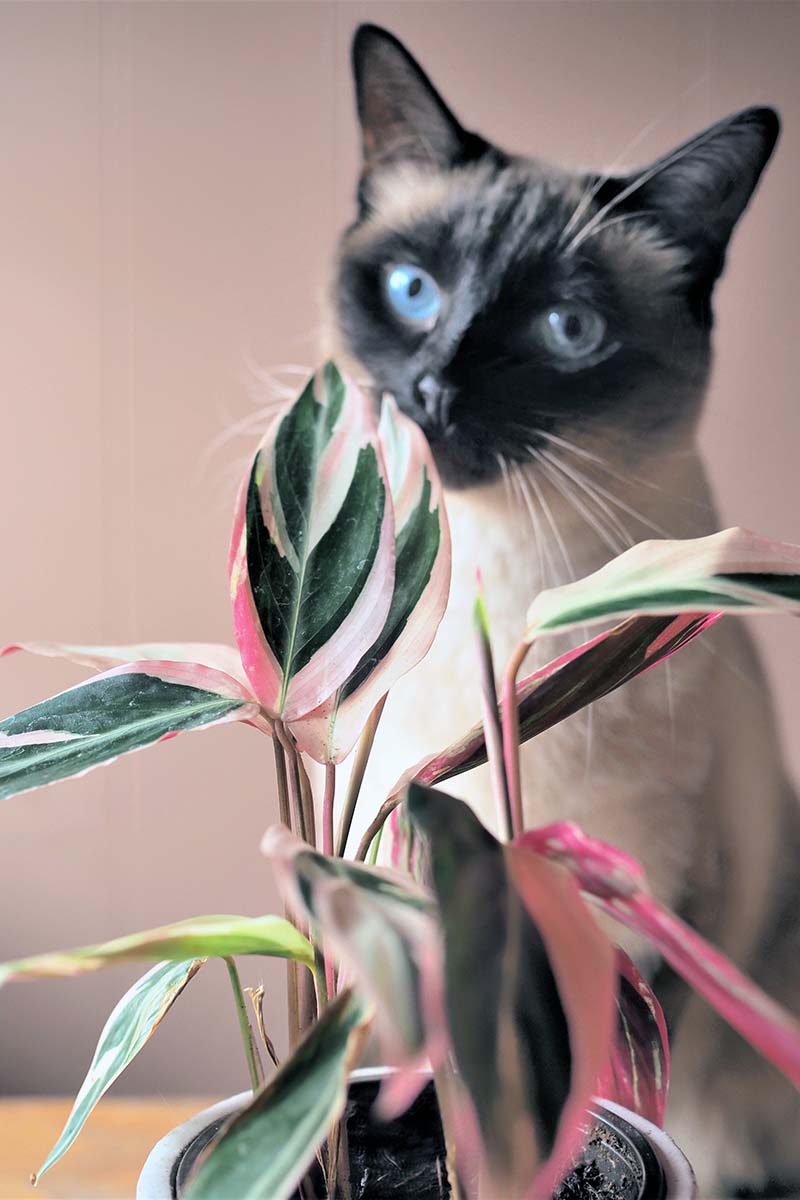
And while those of us who live in regions with cold winters will want to relegate this cultivar to houseplant status, it can also be grown outdoors in dappled shade as an annual, or in Zones 9b through 11 as a perennial.
For those of you in cooler zones who would like to give your houseplant a summer vacation outdoors, be sure to bring it back insides before the temperature dips below 65°F, and check for any signs of pests or disease when you do.
Quick Reference Growing Guide
| Plant Type: | Evergreen herbaceous perennial | Flower/Foliage Color: | Reddish pink and white/variegated light and dark green, cream, and pink |
| Native to: | Brazil | Soil Type: | Peaty, rich |
| Hardiness (USDA Zone): | 9b-11 (outdoors) | Soil pH: | 6.1-7.3 |
| Exposure: | Medium indirect light. | Soil Drainage: | Well-draining |
| Bloom Time/Season: | Spring-summer (outdoors) | Companion Planting: | Begonia, monstera, orchid, philodendron, pilea, sansevieria, spider plant |
| Time to Maturity: | 2-5 years | Uses: | Ornamental houseplant |
| Height: | 3-5 feet | Order: | Zingiberales |
| Spread: | 2-3 feet | Family: | Marantaceae |
| Water Needs: | Medium | Genus: | Stromanthe |
| Maintenance: | Moderate | Species: | Thalia (formerly Sanguinea) |
| Tolerance: | Humidity, low light | Cultivar: | Triostar (aka Tricolor, Tristar) |
| Common Pests: | Aphids, fungus gnats, mealybugs, root knot nematodes, scale, spider mites | Common Diseases: | Cucumber mosaic virus, Helminthosporium leaf spot, Pyricularia leaf spot, root rot |
Keep Your Star Bright and Shining
Now you have all the details to keep your ‘Triostar’ looking stellar all year long – just remember to water it before the soil gets dry, and provide it with medium, indirect light and some extra humidity.
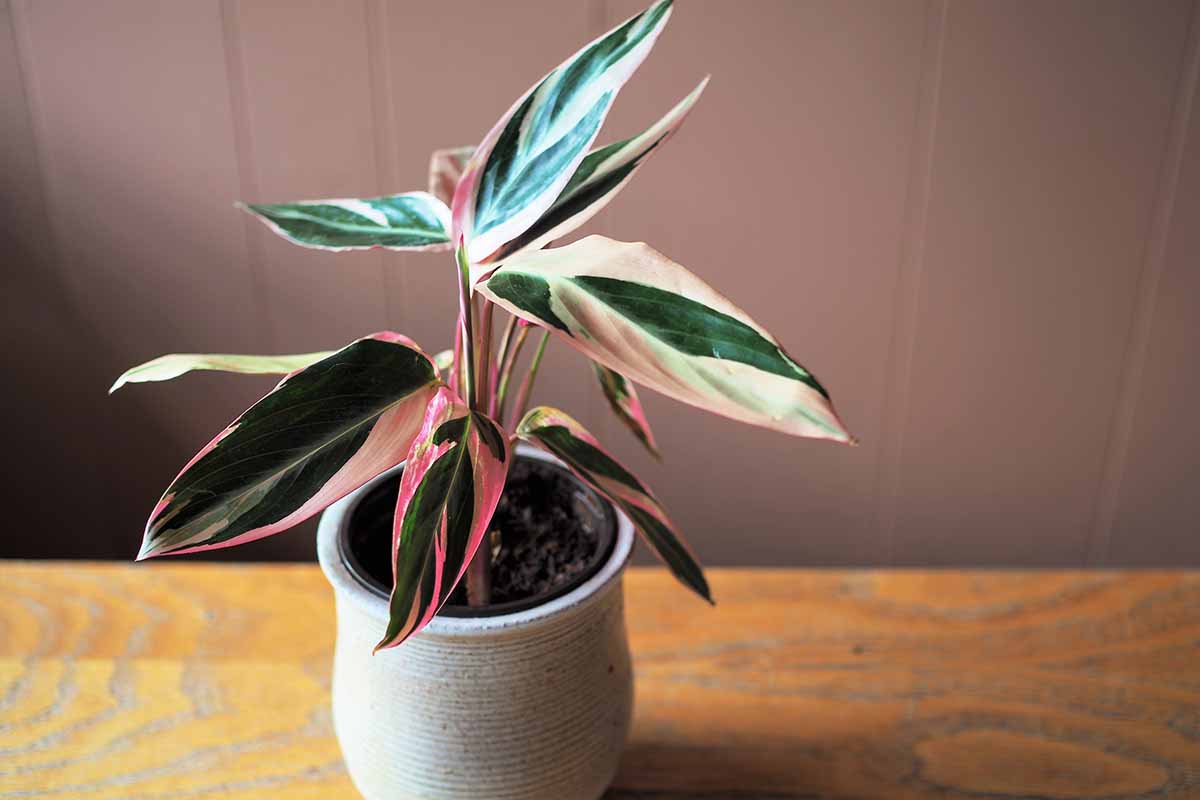
Have you tried growing this lovely cultivar? Do you have any of your own tried and true tips to share with our readers that help you to keep your prayer plant happy and healthy? Let us know in the comments section below!
And for more information about prayer plants, have a read of these guides next:
